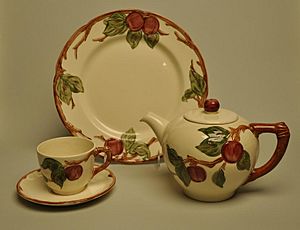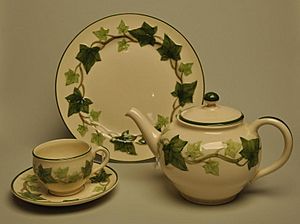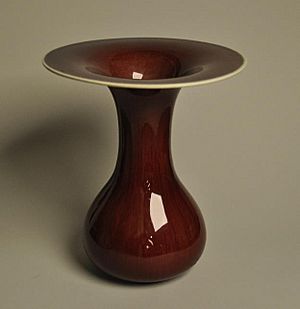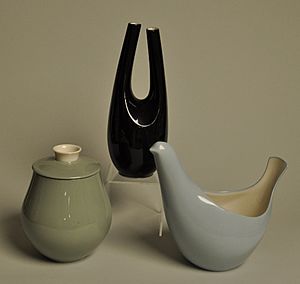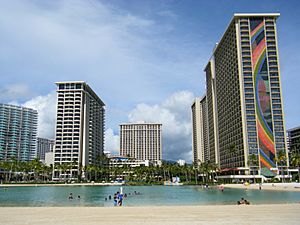Franciscan Ceramics facts for kids
| Industry | Ceramic manufacturing |
|---|---|
| Fate | Acquired |
| Predecessor | Gladding, McBean & Company |
| Successor | Waterford Wedgwood |
| Founded | 1962 |
| Defunct | 1984 |
| Headquarters | , |
|
Key people
|
Antholl McBean Frederic J. Grant |
| Products | Tableware, tile |
| Parent | Interpace 1962-1979 Wedgwood 1979-1984 |
Franciscan Ceramics makes beautiful ceramic tableware (like plates and cups) and tiles. These products were first made by Gladding, McBean & Co. in Los Angeles, California, starting in 1934. Over the years, different companies owned the brand. These included International Pipe and Ceramics (Interpace) from 1962 to 1979, and then Wedgwood from 1979 to 1983.
In 1983, Wedgwood closed the Los Angeles factory. They moved the production of Franciscan dinnerware to England. Later, in 1986, Waterford Glass Group plc bought Wedgwood, creating Waterford Wedgwood. Today, the Franciscan brand is part of a group called WWRD. This stands for "Wedgwood Waterford Royal Doulton." WWRD still makes some of the most famous Franciscan patterns, like Desert Rose and Apple.
The company used different names for its products over time. For dinnerware, they used Franciscan Pottery, Franciscan Ware, and Franciscan. For tiles, names like Gladding, McBean and Hermosa were used. They made many types of ceramics, including garden pots, dinnerware, art pieces, and tiles. Now, only the "Franciscan" name is used for tableware.
Contents
The Start: Gladding, McBean & Co.
Gladding, McBean started in 1875. It was a partnership between Charles Gladding, Peter McGill McBean, and George Chambers. The company grew from one factory in California to many plants. They made clay products like sewer pipes and architectural decorations.
In 1927, Gladding, McBean & Co. joined with another company. This made them the biggest maker of terra cotta (a type of clay) west of the Mississippi River.
Making Dinnerware in Tough Times
The economic collapse of 1929 hit many businesses hard. Gladding, McBean & Co. saw their sales drop. People weren't building new homes, so there was less demand for their bricks and tiles. To make up for lost money, the company started making dinnerware and art pieces in 1933. They used a factory they had bought earlier, which they called the Glendale plant.
In 1934, Frederic J. Grant joined the company. He became the manager of the new dinnerware division. His wife, Mary K. Grant, was an art director. She helped design the pottery lines.
At the time, other companies in Southern California made solid-colored dinnerware. But their products often developed tiny cracks called "crazing." Gladding, McBean & Co. used a special clay called Malinite. This clay, along with a unique firing process, stopped their dinnerware from crazing. This was a big advantage! They also used new "tunnel kilns" that allowed them to make pottery faster.
Mary K. Grant became the Lead Stylist in 1936. She designed many of the shapes and patterns for Franciscan Ware. The company also bought designs from other artists. Max Compton, a ceramic expert, developed many unique glazes. One famous glaze was an "oxblood" red. Another was a "Persian blue" with a pebble effect.
In 1937, Gladding, McBean & Co. bought Catalina Clay Products. They moved the production of Catalina pottery to their Glendale plant.
Popular Patterns and Fine China
In 1940, Gladding, McBean & Co. introduced their first hand-painted dinnerware. This was the famous Franciscan Apple pattern. Soon after, in 1941, came Desert Rose. Desert Rose became one of the company's best-selling dinnerware lines ever!
In 1942, the company started making fine china. This was a more expensive and delicate type of dinnerware. Max Compton developed the glazes, and Mary K. Grant designed the shapes and patterns.
During World War II, the company focused on making existing products. They stopped introducing new lines. After the war, the ceramic industry in Southern California boomed. Many companies made pottery to meet the high demand.
In 1948, they introduced Encanto, a new line of Franciscan fine china. They also launched Franciscan Ivy, another popular hand-painted pattern.
Changes in Leadership and New Designs
In 1952, there were big changes at Gladding, McBean & Co. Atholl McBean, who had led the company for many years, retired. Frederic and Mary Grant also left the company.
A new design team was formed. Mary Jane Winans became the chief designer. George T. James and Otto Lund also joined the team. This new group quickly started creating new dinnerware shapes and patterns.
In 1954, the company launched a promotion called "Modern Americana." This included new patterns like Starburst and Flair White. These designs were meant to look modern and fit with the popular hand-painted patterns like Apple and Desert Rose.
In 1955, Gladding, McBean & Co. introduced a new art ware line called Contours. These pieces were designed by George T. James. However, this line didn't sell well and was soon stopped.
By the late 1950s, many foreign products were coming into the American market. New materials like melamine (used in Melmac) and CorningWare also became popular. This put pressure on Gladding, McBean & Co. to make cheaper dinnerware. They introduced some lower-priced lines, but their dinnerware sales still dropped. To grow, the company decided to join with a company on the East Coast.
Interpace: A New Chapter
In 1962, Gladding, McBean & Company merged with Lock Joint Pipe Company. This created a new, much larger company called International Pipe and Ceramics Corporation. This new company became one of the biggest in the United States. Its name was later shortened to Interpace.
The former Gladding, McBean factory in Los Angeles became Franciscan Ceramics, Inc., a division of Interpace.
New Designers and Big Projects
In 1963, artist Millard Sheets was hired as a consultant. He helped create a new design team for both tiles and dinnerware. Many talented artists joined, including Dora De Larios, Harrison McIntosh, Jerry Rothman, Richard Petterson, and Helen Richter Watson.
The tile design team created amazing large wall murals. Some famous examples that you can still see today include:
- The Jules Stein Eye Institute at UCLA, designed by Mary Blair (1966).
- The Honolulu Hilton Rainbow hotel in Hawaii, designed by Millard Sheets (1968).
- The Disney World Contemporary Resort in Florida, also designed by Mary Blair (1970).
- The Los Angeles City Hall East building, designed by Millard Sheets (1972).
The dinnerware team designed the Madeira line. This was a very popular collection. One of the best-selling patterns on the Madeira shape was simply called Madeira.
Expanding the Business
In 1968, Interpace bought Shenango China. This company made Castleton China and supplied dinnerware to restaurants. In 1969, Interpace also bought Tiffin Glass Company. This allowed them to make glass items that matched their Franciscan dinnerware.
To sell Franciscan ware in Europe, Interpace bought two English companies: Alfred Meakin and Myott, Son & Co. Ltd.
However, by the mid-1970s, the economy was tough. In 1977, Franciscan stopped making all fine china products. Many designers retired or left the company.
Wedgwood Takes Over
In 1979, Interpace sold the Franciscan Ceramics division to Wedgwood. Other parts of Interpace were sold off too. All glassware sold under the Franciscan name was stopped. Interpace itself closed down in 1984.
In 1984, Wedgwood closed the original Franciscan Ceramics factory in Los Angeles. The production of the most popular Franciscan patterns, Desert Rose and Apple, moved to Wedgwood's Johnson Brothers division in England. All other dinnerware and tile lines were stopped. Many historical examples of Franciscan ware were sent to the Wedgwood Museum.
In 1986, Waterford Glass Group plc bought Wedgwood. The combined company was named Waterford Wedgwood. In 2009, a company called KPS Capital Partners bought Waterford Wedgwood. The Franciscan brand became part of WWRD, which stands for "Wedgwood Waterford Royal Doulton."
Today, WWRD still makes the Franciscan Desert Rose and Apple patterns in China. In 2015, Fiskars Corporation, a company from Finland, bought WWRD. This means Franciscan is now part of the Fiskars family of brands.
Franciscan in Pop Culture
Franciscan dinnerware has been very popular and has appeared in many movies and TV shows!
- In Golden Girls, the characters sometimes drink tea from a Desert Rose Teapot.
- In I Dream of Jeannie, Captain Tony Nelson's dinnerware is Franciscan Apple.
- In I Love Lucy, the Ricardo family uses Franciscan Ivy dinnerware. Lucy also has Franciscan fine china for special events.
- In Malcolm in the Middle, the family's dinnerware is Franciscan Larkspur.
- At Graceland, Elvis Presley's home, his dinnerware was Franciscan Apple.
- In 1962, the John F. Kennedy administration bought special Franciscan fine china for Air Force One. It had the seal of the President of the United States on it.
- In the 2013 movie "Gangster Squad", Desert Rose dishes are seen on the breakfast table.
- In Northern Exposure, Desert Rose china is in Maggie's home.
- In Better Call Saul, Saul uses Franciscan Sundance china.
- A 1990s Got Milk? commercial features Franciscan Eclipse Starburst cups and saucers.
- In the 1999 movie Blast from the Past, Franciscan Starburst plates are used at a dinner party.
- In The Big Bang Theory, Amy Farrah Fowler's mother has Franciscan Apple dishes.
- In Gilmore Girls, Babette's dishes are Franciscan Apple.
- In the 2020 TV series Lovecraft Country, Hippolyta's breakfast dishes are Desert Rose.



